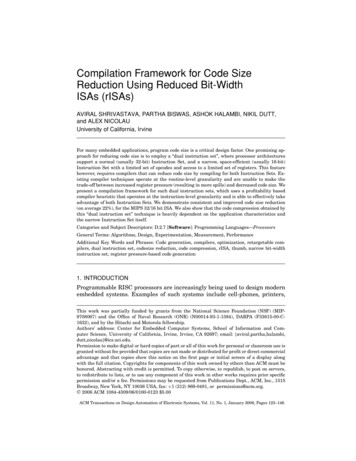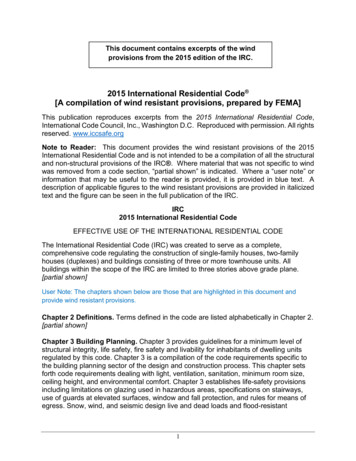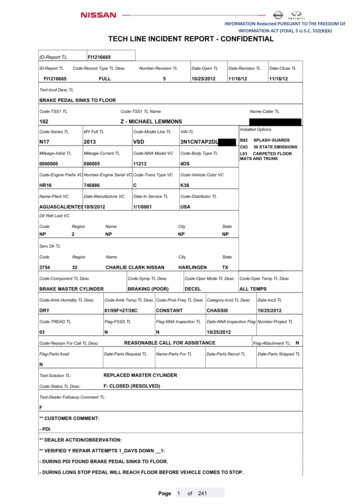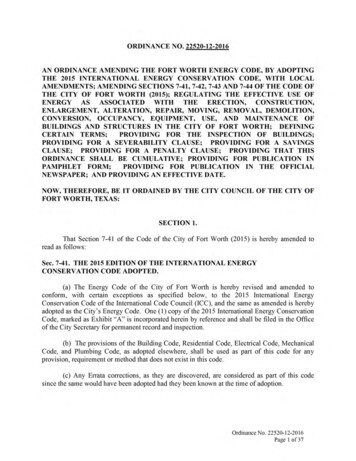
Transcription
Compilation Framework for Code SizeReduction Using Reduced Bit-WidthISAs (rISAs)AVIRAL SHRIVASTAVA, PARTHA BISWAS, ASHOK HALAMBI, NIKIL DUTT,and ALEX NICOLAUUniversity of California, IrvineFor many embedded applications, program code size is a critical design factor. One promising approach for reducing code size is to employ a “dual instruction set”, where processor architecturessupport a normal (usually 32-bit) Instruction Set, and a narrow, space-efficient (usually 16-bit)Instruction Set with a limited set of opcodes and access to a limited set of registers. This featurehowever, requires compilers that can reduce code size by compiling for both Instruction Sets. Existing compiler techniques operate at the routine-level granularity and are unable to make thetrade-off between increased register pressure (resulting in more spills) and decreased code size. Wepresent a compilation framework for such dual instruction sets, which uses a profitability basedcompiler heuristic that operates at the instruction-level granularity and is able to effectively takeadvantage of both Instruction Sets. We demonstrate consistent and improved code size reduction(on average 22%), for the MIPS 32/16 bit ISA. We also show that the code compression obtained bythis “dual instruction set” technique is heavily dependent on the application characteristics andthe narrow Instruction Set itself.Categories and Subject Descriptors: D.2.7 [Software]: Programming Languages—ProcessorsGeneral Terms: Algorithms, Design, Experimentation, Measurement, PerformanceAdditional Key Words and Phrases: Code generation, compilers, optimization, retargetable compilers, dual instruction set, codesize reduction, code compression, rISA, thumb, narrow bit-widthinstruction set, register pressure-based code generation1. INTRODUCTIONProgrammable RISC processors are increasingly being used to design modernembedded systems. Examples of such systems include cell-phones, printers,This work was partially funded by grants from the National Science Foundation (NSF) (MIP9708067) and the Office of Naval Research (ONR) (N00014-93-1-1384), DARPA (F33615-00-C1632), and by the Hitachi and Motorola fellowship.Authors’ address: Center for Embedded Computer Systems, School of Information and Computer Science, University of California, Irvine, Irvine, CA 92697; email: ermission to make digital or hard copies of part or all of this work for personal or classroom use isgranted without fee provided that copies are not made or distributed for profit or direct commercialadvantage and that copies show this notice on the first page or initial screen of a display alongwith the full citation. Copyrights for components of this work owned by others than ACM must behonored. Abstracting with credit is permitted. To copy otherwise, to republish, to post on servers,to redistribute to lists, or to use any component of this work in other works requires prior specificpermission and/or a fee. Permissions may be requested from Publications Dept., ACM, Inc., 1515Broadway, New York, NY 10036 USA, fax: 1 (212) 869-0481, or permissions@acm.org. C 2006 ACM 1084-4309/06/0100-0123 5.00ACM Transactions on Design Automation of Electronic Systems, Vol. 11, No. 1, January 2006, Pages 123–146.
124 A. Shrivastava et al.modems, handhelds etc. Using RISC processors in such systems offers the advantage of increased design flexibility, high computing power and low on-chippower consumption. However, RISC processor systems suffer from the problem of poor code density which may require more ROM for storing programcode. As a large part of the IC area is devoted to the ROM, this is a severelimitation for large volume, cost sensitive embedded systems. Consequently,there is a lot of interest in reducing program code size in systems using RISCprocessors.Traditionally, ISAs have been fixed width (e.g., 32-bit SPARC,64-bit Alpha)or variable width (e.g., x86). Fixed width ISAs give good performance at the costof code size and variable width ISAs give good performance at the cost of addeddecode complexity. Neither of the above are good choices for embedded processors where performance, code size, power, all are critical constraints. Dualwidth ISAs are a good tradeoff between code size flexibility and performance,making them a good choice for embedded processors. Processors with dual withISAs are capable of executing two different Instruction-Sets. One is the “normal” set, which is the original instruction set, and the other is the “reducedbit-width” instruction set that encodes the most commonly used instructionsusing fewer bits. A very good example is the ARM [Advanced RISC Machines,Ltd. 2003] ISA with a 32-bit “normal” Instruction Set and a 16-bit InstructionSet called “Thumb.”Other processors with a similar feature include the MIPS 32/16 bit TinyRISC[LSI LOGIC 2000], ST100 [ST Microelectronics 2004] and the Tangent A5 [ARCCores 2005]. We term this feature as the “reduced bit-width Instruction SetArchitecture” (rISA).Processors with rISA feature dynamically translate (or decompress, or expand) the narrow rISA instructions into corresponding normal instructions.This translation usually occurs before or during the decode stage. Typically,each rISA instruction has an equivalent instruction in the normal instructionset. This makes translation simple and can usually be done with minimal performance penalty. As the translation engine converts rISA instructions intonormal instructions, no other hardware is needed to execute rISA instructions.If the whole program can be expressed in terms of rISA instructions, then upto 50% code size reduction can be achieved.The fetch-width of the processor being the same, the processor when operating in rISA mode fetches twice as many rISA instructions (as compared tonormal instructions) in each fetch operation. Thus, while executing rISA instructions, the processor needs to make lesser fetch requests to the instructionmemory. This results in a decrease in power and energy consumption by theinstruction memory subsystem.Typically, each rISA instruction has an equivalent instruction in the normalinstruction set. This makes the translation from rISA instructions to normalinstructions very simple. Research [Benini et al. 2001; Lekatsas et al. 2000]have shown that the translation unit for a rISA design can be very small and canbe implemented in a fast, power efficient manner. Furthermore, we have shownthat significant energy savings achieved by executing rISA code [Shrivastavaand Dutt 2004].ACM Transactions on Design Automation of Electronic Systems, Vol. 11, No. 1, January 2006.
Compilation Framework for Code Size Reduction Using rISAs 125Thus, the main advantage of rISA lies in achieving low code size and lowenergy consumption with minimal hardware alterations. However, since morerISA instructions are required to implement the same task, rISA code hasslightly lower performance compared to the normal code.Although the theoretical limit of code size reduction achievable by rISA is50%, severe restrictions on the rISA IS severely limit the compiler capabilityto achieve so. The rISA IS, because of bit-width restrictions, can encode only asmall subset of the normal instructions. Thus, not all normal instructions canbe converted into rISA instructions, and sometimes more than one rISA instruction may be the equivalent of one normal instruction. As a result, indiscriminateconversion to rISA instructions may result in an increase in code size. Again,due to bit-width restrictions rISA instructions can access only a restricted setof registers. For example, the ARM-Thumb allows access to 8 registers out of16 general purpose ARM registers. As a result indiscriminate conversion ofnormal instructions to rISA instructions may result in register spilling, andthus degradation in performance and increase in code size. Furthermore, several options available in normal IS like predication and speculation may notbe available in the rISA mode. Such severe restrictions on the rISA IS makethe code-size reduction obtainable by using rISA very sensitive to the compilerquality, the application features and the rISA Instruction Set itself.The compiler technology to generate code for rISA architectures is still primitive and does not consider all the trade-offs. To simplify the problem of codegeneration for a rISA processor, compilers usually perform the conversion ata routine-level granularity. In other words, all the instructions in a routinehave to be in one mode, normal or rISA. This simplification misses out severalsignificant opportunities to convert only the profitable regions of a routine.This article makes three main contributions:— We propose conversion to rISA instructions at a instruction-level granularity— We present a novel compilation framework to exploit the conversion of instruction at instruction-level granularity, and show that our approach resultsin on average 22% code compression, which is much more than the achievablecode compression by previous techniques.— Finally, we use our retargetable code generation technique to explore severalinteresting rISA designs. Our analysis reveals that the code compressionachieved by rISA is heavily dependent on the application characteristics andthe rISA design itself. It is therefore very important for application specificprocessors to carefully design and tune the rISA.The rest of the article is organized as follows: Section 2 discusses the hardware and software aspects of implementing a reduced bit-width InstructionSet Architecture. Section 3 discusses the impact of these architectural featureson the achievable code compression. Section 4 describes previous compilationtechniques to exploit rISA. Section 5 describes our compilation frameworkto performs rISAization at instruction-level granularity to achieve highcompression. Section 5.2 describes the key contribution of this article, thatis, a register-pressure-based profitability heuristic to decide whether or notACM Transactions on Design Automation of Electronic Systems, Vol. 11, No. 1, January 2006.
126 A. Shrivastava et al.Fig. 1. Normal and rISA instructions co-exist in Memory.to convert a sequence of normal instructions to rISA instructions. Convertingat instruction-level granularity incurs a penalty in the form of extra instructions that are needed for explicit mode change. Section 5.4 first defines andthen solves the problem of optimally inserting mode change instructions. InSection 6, we first show the efficacy of our compilation approach, and thenperform exploration of several interesting rISA designs. We conclude withongoing research directions in Section 7.2. REDUCED BIT-WIDTH INSTRUCTION SETA rISA processor is one which supports instructions from two different Instruction Sets. One is the “normal” 32-bit wide Instruction Set, and the other is the“narrow” 16-bit wide Instruction Set. The “narrow” instructions comprise thereduced bit-width Instruction Set rIS. The code for a rISA processor containsboth normal and rISA instructions, but the processor dynamically converts therIS instructions to normal instructions, before or during the instruction decodestage.2.1 rISA: Software Aspects2.1.1 Adherence to Word Boundary. The code for rISA processors containsinstructions from both the instruction sets, as shown in Figure 1(a). Manyarchitectures impose the restriction that all code should adhere to the wordboundary.In order for the normal instructions to adhere to the word boundary, therecan be only even number of contiguous rISA instructions. To achieve this, a rISAinstruction that does not change the state of the processor is needed. We termsuch an operation as rISA nop. The compiler can then pad odd-sized sequenceof rISA instructions with rISA nop, as shown in Figure 1(b). ARM-Thumb andMIPS32/16 impose such architectural restrictions, while the ARC processor candecode the instructions even if they cross the word boundary.2.1.2 Mode Change Instructions. rISA processors operate in two modes,the normal mode and the rISA mode. In order to change the execution modeof a processor dynamically, there should be a mechanism in software to specify change in execution mode. For most rISA processors, this is accomplishedusing explicit mode change instructions. We term an instruction in the normal instruction set that changes mode from normal to rISA the mx instruction,and an instruction in the rISA instruction set that changes mode from rISA toACM Transactions on Design Automation of Electronic Systems, Vol. 11, No. 1, January 2006.
Compilation Framework for Code Size Reduction Using rISAs 127Fig. 2. Simple translation of Thumb instruction to ARM instruction.normal the rISA mx instruction. The code including the mode change instructions is shown in Figure 1(c).In ARM/Thumb, ARM instructions BX or BLX switch the processor to Thumbmode. The ARM BX instruction is a version of a ARM branch instruction, whichchanges the execution mode of the processor to rISA mode. Similarly, the ARMBLX instruction is a version of ARM BL instruction (Branch and Link), withthe additional functionality of switching the processor to rISA mode. Similarearmarked instructions also exist in the Thumb instruction set to switch theprocessor back to the normal mode of operation. The MIPS16 ISA has an interesting mechanism for specifying mode changes. All routines encoded usingMIPS16 instructions begin at the half word boundary. Thus, calls (and returns)to half word aligned addresses change the mode from normal to rISA. The ARCTangent A5 processor on the other hand allows native execution of the ARCompact instructions. No special instruction is required to switch modes.2.2 rISA: Hardware AspectsAlthough the code for a rISA processor contains instructions from both theInstruction Sets, the instruction fetch mechanism of the processor is obliviousof the presence of rISA instructions. The fetched code is interpreted (decoded) asnormal or rISA instruction depending on the operational mode of the processor.When the processor is in rISA mode, the fetched code is assumed to contain tworISA instructions. The first one is translated into normal instruction, while thesecond one is latched and kept for the next cycle of execution.Figure 2 shows an example of translation of a Thumb-ADD instruction toa normal ARM-ADD instruction. The translation can be realized in terms ofsimple and small table look-ups. Since the conversion to normal instructionsis done during or before the instruction-decode stage, the rest of the processorremains same. To provide support for rISA typically only decode logic of theprocessor needs to be modified. The rISA instructions can be decoded by eithersingle-step decoding or two-step decoding.Figure 3 shows the one-step decoding of rISA instructions. The single stepdecoding of rISA instructions is just like performed at the same time as theACM Transactions on Design Automation of Electronic Systems, Vol. 11, No. 1, January 2006.
128 A. Shrivastava et al.Fig. 3. Single-step decoding of rISA instructions.Fig. 4. Two-step decoding of Thumb instructions.decoding of the normal instructions. Single-step decoding is typically simplerbecause of the rISA instructions are “narrow”.In the two-step decoding shows in Figure 4, the rISA instructions are firsttranslated to normal instructions. The normal instructions can then be decodedas before. Although such implementation requires minimal logical changes tothe existing architecture, it may lengthen the cycle time. ARM7TDMI implements two step decoding approach of Thumb instructions.3. COMPILATION ISSUES FOR RISAAlthough up to 50% code compression can be achieved using rISA, owing tosevere restrictions on the number of operations, register accessibility and reduced functionality, it is in practice tough to consistently achieve more than30% code size reduction. In order to alleviate such severe constraints, severalsolutions have been proposed. We discuss several such architectural featuresin the light of aiding code generation in rISA processors.3.1 Granularity of rISAizationWe term the compiler-process of converting normal instructions into rISAinstructions as rISAization. Existing compilers like the ARM-Thumb compiler (as yet) supports the conversion at a routine level granularity. Thus, allthe instructions in a routine can be in exactly one mode, the normal ARMmode, or the Thumb mode. A routine cannot have instructions from both theACM Transactions on Design Automation of Electronic Systems, Vol. 11, No. 1, January 2006.
Compilation Framework for Code Size Reduction Using rISAs 129Fig. 5. Code compression achieved by routine-level rISAization.ISAs. Furthermore, existing Compilers rely on human analysis to determinewhich routines to implement in ARM instructions, and which ones in Thumbinstructions.Figure 5 plots the code compression achieved by MIPS32/16 compiler performing indiscriminate rISAization. The compiler could achieve 38% code compression on diff benchmark, that has only one routine and low register pressure.All the instructions could be mapped to rISA instructions. However, on 1dpic,the most important routine had high register pressure, that resulted in register spilling and thus leading to an increase in code size. The case with adiiis similar. Some other benchmarks had routines in which the conversion resulted in an increase in the code size. Thus, although routine-level granularityof rISAization can achieve high degrees of code compression on small routines,it is unable to achieve decent code compression on application level. In fact,MIPS32/16 compiler could achieve only 15% code size reduction on our set ofbenchmarks. This is because not many routines can be found whose conversionresults in substantial code compression. The inability to compress code is dueto two main reasons: (i) rISAization may result in an increase in code size and(ii) rISAization of routines that have high register pressure results in registerspills and thus increase in the code.Figure 6 explains the two major drawbacks of rISAizing at routine-levelgranularity and shows that instruction-level granularity alleviates thesedrawbacks.First, a routine-level granularity approach misses out on the opportunityto rISAize code sections inside a routine, which is deemed non profitable torISAize. It is possible that it is not profitable to rISAize a routine as a whole,but some parts of it can be profitably rISAized. For example, the Function 1and Function 3 are found to be nonprofitable to rISAize as a whole. Traditionalroutine-level granularity approaches will therefore not rISAize these routines,ACM Transactions on Design Automation of Electronic Systems, Vol. 11, No. 1, January 2006.
130 A. Shrivastava et al.Fig. 6. Routine level granularity versus instruction level granularity.while instruction-level granularity approaches will be able to achive some codesize reduction by identifying and rISAizing only some profitable portions of theroutine.Second, the compiler is not able to leave out some regions of code inside aroutine that may incur several register spills. It is possible that leaving out somepeices of code inside a profitable routine may increase the code compressionachieved. For example, in Figure 6, the instruction-level granularity approacheshave the choice to leave out some regions of code inside a routine to achievehigher code compression.Thus, consistently high degree of code compression can be achieved by rISAization at instruction level granularity. However, instruction-level granularity of rISAization has some overheads. Instruction-level granularity of rISAization needs explicit mode change instructions. We define a normal instruction mxchanges the execution mode of the processor from normal to rISA, while a rISAinstruction rISA mx changes the execution mode of the processor from rISAmode to normal mode. The mode change instructions have to be inserted in thecode at the boundaries of normal and rISA instructions. Unlike the conversionat routine level granularity, this causes an increase in code size. But our resultsshow that, even with this code-size penalty, consistently higher degrees of codecompression can be achieved by rISAization at instruction-level granularity.3.2 rISA Instruction SetThe rISA instruction set is tightly constrained by the instruction width. Typicalinstruction sets have three operand instructions; two source operands and onedestination operand. Only 16 bits are available to encode the opcode field andthe three operand fields. The rISA design space is huge, and several instructionset idiosyncrasies makes it very tough to characterize. As shown in Figure 7,we informally define rISA wxyz as a rISA instruction set with opcode widthw-bits, and three operands widths as x-bit, y-bit, and z-bits respectively. Mostinteresting rISA instruction sets are bound by rISA 7333 and rISA 4444.The rISA 7333 format describes an instruction set in which the opcode field is7-bit wide, and each operand is 3-bit wide. Such an instruction set would contain128 instructions, but each instruction can access only 8 registers. Although suchACM Transactions on Design Automation of Electronic Systems, Vol. 11, No. 1, January 2006.
Compilation Framework for Code Size Reduction Using rISAs 131Fig. 7. rISA instruction format.a rISA instruction set can rISAize large portions of code, but register pressuremay become too high to achieve a profitable encoding. On the other extremeis the rISA 4444 format, which has space for only 16 instructions, but eachinstruction can access up to 16 registers. For applications that do not use a widevariety of instructions, but have high register pressure, such a rISA instructionset is certainly a good choice.The design space between the two extremes is huge. All realistic rISA instruction sets contain a mix of both type of instructions, and try to achievethe “best of both worlds”. Designing a rISA instruction set is a essentially atrade-off between encoding more instructions in the rISA instruction set, andproviding rISA instructions access to more registers.The “implicit operand format” of rISA instructions is a very good example ofthe trade-off the designers have to make while designing rISA. In this feature,one (or more) of the operands in the rISA instruction is hard-coded (i.e., implied).The implied operand could be a register operand, or a constant. In case a frequently occurring format of add instruction is add Ri Ri R j (where the first twooperands are the same), a rISA instruction rISA add1 Ri R j , can be used. Incase an application that access arrays produces a lot of instructions like addr addr 4, then a rISA instruction rISA add4 addr which has only one operandmight be very useful. The translation unit, while expanding the instruction,can also fill in the missing operand fields. This is a very useful feature thatcan be used by the compiler to generate good quality code. ARC Tangent A5processor uses this feature extensively to optimize ARCompact instruction set[ARC Cores 2005].3.3 Limited Access to RegistersrISA instructions usually have access to only a limited set of processor registers. This results in increased register pressure in rISA code sections. A veryuseful technique to increase the number of useful registers in rISA mode is toimplement a rISA move instruction that can access all registers. This is possible because a move operation has only two operands and hence has more bitsto address each operand.3.4 Limited Width of Immediate OperandsA severe limitation of rISA instructions is the inability to incorporate large immediate values. For example, with only 3 bits are available for operands, themaximum unsigned value that can be expressed is 7. Thus, it might be useful tovary the size of the immediate field-depending on the application and the valuesthat are (commonly) generated by the compiler. Increasing the size of the immediate fields, however, reduces the number of bits available for opcodes (and alsoACM Transactions on Design Automation of Electronic Systems, Vol. 11, No. 1, January 2006.
132 A. Shrivastava et al.the other operands). Several architectures implement a rISA extend instruction, which extends the immediate field in the next rISA instruction. Such aninstruction is very useful to be able to rISAize contiguous large portions of code.4. RELATED WORKMany leading 32-bit embedded processors also support the 16-bit (rISA) instruction set to address both memory and energy consumption concerns of theembedded domain [Advanced RISC Machines, Ltd. 2003; LSI LOGIC 2000; STMicroelectronics 2004; ARC Cores 2005].There has been previous research effort to achieve further code compressionwith the help of architectural modifications to rISA. The ARM Thumb IS wasredesigned by Kwon et al. [1999a] to compress more instructions and furtherimprove the efficiency of code size reduction. This new Instruction Set is calledPartitioned Register Extension (PARE), reduces the width of the destinationfield and uses the saved bit(s) for the immediate addressing field. The registerfile is split into (possibly overlapping) partitions, and each 16-bit instructionscan only write to a particular partition. This reduces the number of bits requiredto specify the destination register. With a PARE-aware compiler, the authorsclaim to have achieved a compression ratio comparable to Thumb and MIPS16.Another direction of research in rISA architectures has been to overcome theproblem of decrease in performance of rISA code. Kwon et al. [1999b] proposeda parallel architecture for executing rISA instructions. TOE(Two OperationExecution) exploits Instruction Level Parallelism provided by the compiler. Inthe TOE architecture all rISA instruction occur in pairs. With 1-bit specifyingthe eligibility of the pair of rISA instructions to execute in parallel, the performance of rISA can be improved. Since the parallelization is done by the compiler,the hardware complexity remains low.Krishnaswamy and Gupta [2003] observed that there exist Thumb instruction pairs that are equivalent to single ARM instructions throughout the 16-bitThumb code. They enhanced the Thumb instruction set by an AX (Augmenting Extensions) instructions. Compiler finds the pairs of Thumb instructionsthat can be safely executed as single ARM instruction, and replace them byAX Thumb instruction pairs. They coalesce the AX with the immediately following Thumb instruction at decode time and generate an ARM instruction toexecute single instruction, thus increasing performance.While there has been considerable research in the design of architectures/architectural features for rISA, the compiler techniques employed to generatecode targeted for such architectures are rudimentary. Most existing compilerseither rely on user guidance or perform a simple analysis to determine whichroutines of the application to code using rISA instructions. These approaches,which operate at the routine level granularity, are unable to recognize opportunities for code size optimization within routines. We propose instruction-levelgranularity of rISAization and present compiler frmaework to generate optimized code for such rISA architectures. Our technique, is able to aggressivelyreduce code size by discovering codesize reduction opportunities inside a routine, resulting in high degrees of code compression.ACM Transactions on Design Automation of Electronic Systems, Vol. 11, No. 1, January 2006.
Compilation Framework for Code Size Reduction Using rISAs 133Fig. 8. Compilation steps for rISA.5. COMPILATION FRAMEWORK FOR rISAWe implemented our rISA compiler technique in the EXPRESS retargetablecompiler. EXPRESS [Halambi et al. 2001] is an optimizing, memory-aware,Instruction Level Parallelizing (ILP) compiler. EXPRESS uses the EXPRESSION ADL [Halambi et al. 1999] to retarget itself to a wide class of processorarchitectures and memory systems. The inputs to EXPRESS are the application specified in C, and the processor architecture specified in EXPRESSION.The front-end is GCC based and performs some of conventional optimizations.The core transformations in EXPRESS include RDLP [Novack and Nicolau1997]—a loop pipelining technique, TiPS : Trailblazing Percolation Scheduling[Nicolau and Novack 1993]—a speculative code motion technique, InstructionSelection and Register Allocation. The back-end generates assembly code forthe processor ISA.A rISA compiler not only needs the ability to selectively convert portions ofapplication into rISA instruction, but also heuristics to perform this conversiononly where it is profitable. Figure 8 shows the phases of the EXPRESS compilerACM Transactions on Design Automation of Electronic Systems, Vol. 11, No. 1, January 2006.
134 A. Shrivastava et al.with our rISAization technique. The code generation for rISA processors inEXPRESS is therefore a multi-step process:5.1 Mark rISA BlocksVarious restrictions on the rISA instruction set, means that several normalinstructions may not be convertible into rISA instructions. For example, an instruction with a large immediate value may not be rISAizable. The first stepin compilation for a rISA processor is thus marking all the instructions thatcan be converted into rISA instructions. However, converting all the marked instructions into rISA instructions may not be profitable, because of the overheadassociated with rISAization. The next step is therefore, to decide which contiguous list of marked instructions are profitable to convert to rISA instructions.Note that a list of contiguous marked instructions can span across basic blockboundaries. To ensure correct execution, mode change instructions need to beadded, so that the execution mode of processor (normal or rISA) matches thatof the instructions it is executing. The instruction selection, however is donewithin basic blocks. Contiguous list of marked instruct
both normal and rISA instructions, but the processor dynamically converts the rIS instructions to normal instructions, before or during the instruction decode stage. 2.1 rISA: Software Aspects 2.1.1 Adherence to Word Boundary. The code for rISA processors contains instructions from both the instruction sets, as shown in Figure 1(a). Many










